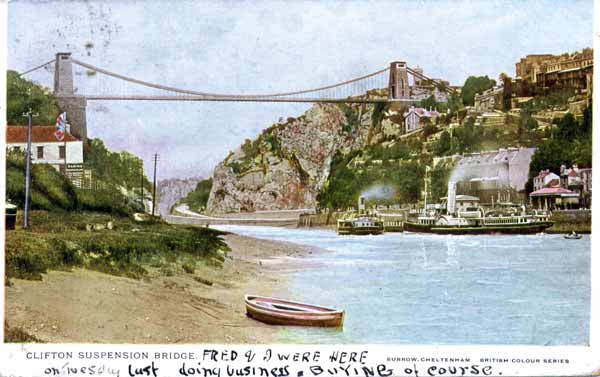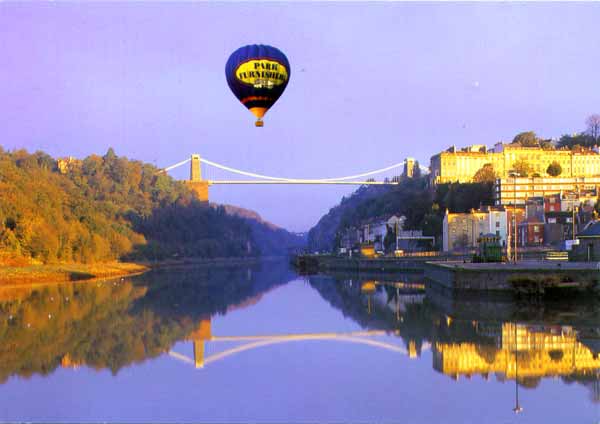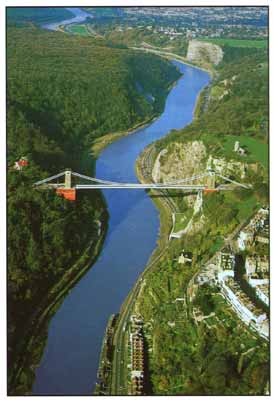
Bristol UK Postcards - Avon Gorge (4)

Clifton Suspension Bridge and the River Avon from Rownham
This postcard, posted in Bristol on August 28th, 1905, has the printed text...
Empire Series, London, N0. 244, Copyright

Clifton Suspension Bridge and the River Avon from Rownham
This unused postcard has the printed text...
2461 - 9
Hartmann trademark logo
Printed in Saxony

Avon Gorge - Clifton Suspension Bridge and the River Avon
This postcard, posted on June 29th, 1907, has the printed text...
Burrow, Cheltenham
British Colour Series
Printed in Great Britain

Avon Gorge - Clifton Suspension Bridge and the River Avon
This postcard, posted on June 29th, 1907, has the printed text...
2057
Photographed and published by Pitkin Unichrome Ltd.
Tel: 01264 409200
Over the Portway road on the right side of the gorge under the bridge can be seen the alpine cover to protect the roadway from falling rocks - and perhaps the suicide jumpers from the bridge.

Avon Gorge - Clifton Suspension Bridge and the River Avon
This unused postcard, advertising Park Furnishers of Willway Street, Bedminster, Bristol, has no othee printed text. Park Furnishers established in 1967 is Brstol's largest independently owned furniture store.

Avon Gorge - Clifton Suspension Bridge and the River Avon
This unused postcard has the printed text...
2DC 676
Photo" E Nagel, F.R.P.S.
John Hinde Original
Published by John Hinde (Distributors Ltd.
Printed in Ireland
Clifton Suspension Bridge spans the
pricipitous Avon Gorge 245 feet above the river, linking
Bristol and Gloucestershire. Designed by Brunel, the
bridge was originally to have been built in 1753 but it was
over 100 years later before the project was completed.
The River Avon is navigable from Bristol to its junction
with the Severn and some trading vessels use the river to
reach the busy dock of Bristol, although larger ships
berth at Avonmouth.
This postcard view is different than most is that is was taken of the Avon Gorge towards the city. The photo was taken before the canopy under the bridge over the A4 Portway road was built. In the rockface on the left can be seen semicircular entrance of Giant's Cave, the entrance of which is through a tunnel down from the Observatory.

Avon Gorge - Paddle Steamer "Waverley"
This unused postcard has the printed text...
Paddle Steamer "Waverley" at Bristol,
from a painting by John Nicholson
Printed by Interprint, Scotton, Knaresborough HG5 9JA. Tel: (0423) 868011
The paddle steamer "Waverley" was built on the Clyde in 1947 and is now the last of the sea going paddle steamers. John Nicolson has painted a lot of ships, but I can't find much about him.

Avon Gorge - Clifton Suspension Bridge and the River Avon
This unused postcard has the printed text...
Photo by Aero Pictorial Ltd.
Excel Series
Printed in England

Avon Gorge - Clifton Suspension Bridge and the River Avon
This unused postcard has the printed text...
2324
Photographed & published by Pitkin Unichrome Ltd.
Tel 01264 409200
In the postcard above the Observatory can be seen on the right, Clifton, side of the bridge. Where the Portway road follows the river in the gorge below the bridge can be seen our own alpine road canopy. The canopy was built to protect the Portway and its users from further rock falls but the position of it still leads many of us to believe it's there to stop suicides from crashing into the roadway. Since it was built there have been around 8 suicides a year from the bridge. In 1994, barriers were erected to cut down the number of jumpers, which have decreased to 4 a year.
Cut by the river Avon through the limestone of the area the Avon Gorge is 700 feet wide and 300 feet deep in the area of the Clifton Suspension Bridge. Bristol has one of the highest tidal ranges in the world, sometimes with a 50ft difference between high and low tides in the Bristol Channel.
That's the (almost) scientific explanation - the REAL reason is far more romantic . . .
Long ago, when the world was young, it was inhabited by a race of giants. Living in the area that would become Bristol were two brothers, Goram and Vincent. Vincent was industrious and hard-working whilst his brother was gluttonous and lazy. Goram suggested that they build a huge mound of rocks and bones as a lasting monument to themselves. Vincent should provide the rocks whilst Goram would provide the bones from his feasting.
Vincent refused but suggested that they build a wonderful channel for a river. Vincent started on his project and was progressing well, whilst Goram watched. It became evident to Goram that his brothers name would live forever whilst his would be forgotten so he decided to build a rival gorge about three miles from Vincent's. Being a lazy fellow he had no pickaxe of his own so borrowed Vincents. The first thing Goram did was to hew a chair for himself so that he may rest from his labours.
In order that they both share the pickaxe the brothers arranged that they should a shout a warning to eachother then throw the pickaxe the three miles between them. This worked well until one day Goram fell asleep in his chair. Vincent shouted a warning and hurled his pickaxe.
Goram, fast asleep, never heard the warning and the result was that the pickaxe hit him in the head and split his skull, killing him. Vincent was filled with remorse and worked even harder. The channel that we know today as the Avon Gorge was soon finished. But, Vincent could still not rest easy. According to the legend he then formed the stone circle at Stanton Drew, then built another at Stonehenge. Still not having felt he had attoned for his brothers death he swam to Ireland and built the Giant's Causeway.
By now Vincent was worn out through his labours and he returned home to spend the last few hours of his life sat upon the rocks of his gorge. If you think this is a bit fanciful, then think on the fact that the stone circles at Stanton Drew and Stonehenge still exist, as does the Giant's Causeway. Also, if the legend isn't true, why should the resting place of Vincent still be called Vincent Rocks? The chair that Goram cut for himself is still there in the grounds of Blaise Castle, as is the Giant's Soapdish.
There is another legend concerning the fate of the giants. Goram and Vincent both fell in love with the beautiful Avona. To decide which was to marry her they were given the task of draining a huge lake. Goram fell asleep during the task and Vincent won the hand of the fair lady. Goram, broken hearted, threw hmself into the River Severn and drowned. Today, the River Avon is named after Avona and the remains of Goram's head and shoulder can be seen as the islands Steep Holm and Flat Holm in the Severn.
This page created 2nd December 2009, last modified 31st March 2010